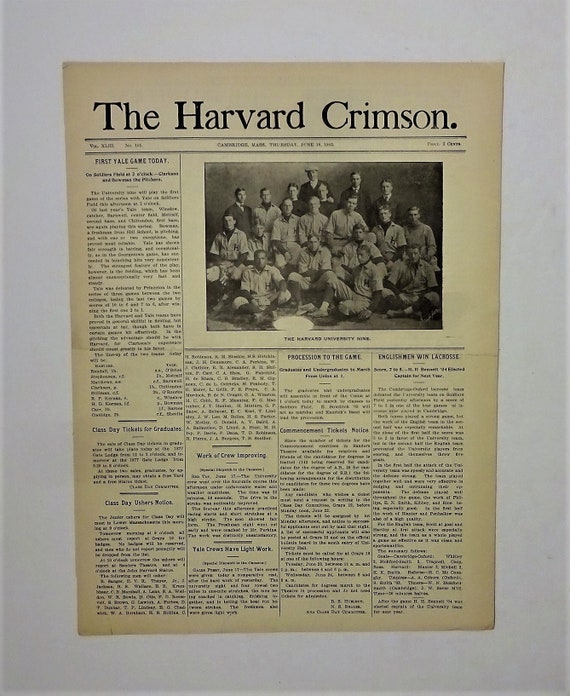When you talk about campus journalism, one name always comes up—Harvard Crimson. It's not just a newspaper; it's a legacy, a tradition, and a cornerstone of student journalism. Founded way back in 1873, this paper has been shaping minds, sparking debates, and influencing generations. So, why is it so special? Well, buckle up because we’re diving deep into its storied past, its impact on journalism, and how it continues to thrive in today’s digital age.
There’s something magical about student-run publications. They give voices to those who might otherwise go unheard. The Harvard Crimson is more than just an outlet for students—it’s a platform that amplifies ideas, challenges norms, and shapes the future of journalism itself. For over a century and a half, it’s been doing exactly that.
As we explore the legacy of this iconic newspaper, we’ll uncover what makes it so unique. From its early days as a humble student publication to becoming one of the most respected names in campus journalism, there’s a lot to unpack. So, let’s get started, shall we?
Table of Contents
- The Rich History of Harvard Crimson
- Mission and Vision: What Drives the Crimson?
- Impact on Journalism and Society
- How It’s Structured: Behind the Scenes
- Notable Alumni and Their Contributions
- Adapting to the Digital Age
- Challenges Faced by the Crimson
- Ethical Standards in Campus Journalism
- The Future of Harvard Crimson
- Conclusion: Why Harvard Crimson Matters
The Rich History of Harvard Crimson
Let’s rewind to 1873, when a group of ambitious undergrads decided they wanted to start their own newspaper. Little did they know that this decision would create a ripple effect felt across the world of journalism. The Harvard Crimson began as a simple weekly publication, but it quickly grew into something much bigger.
Over the years, the Crimson has undergone several transformations. It became a daily publication in 1949, marking a significant milestone in its history. This shift allowed the paper to cover breaking news on campus and beyond, cementing its reputation as a go-to source for information.
Key Milestones in the Crimson's Journey
- 1873: The Harvard Crimson is founded.
- 1949: Transition to daily publication.
- 1970s: Increased focus on investigative journalism.
- 2000s: Embracing digital media.
Each decade brought new challenges and opportunities, but the Crimson adapted and thrived. Its ability to evolve while staying true to its core values is what sets it apart from other student newspapers.
Mission and Vision: What Drives the Crimson?
Every great organization has a mission, and the Harvard Crimson is no exception. Their mission is simple yet powerful: to provide a platform for students to express themselves, hold power accountable, and foster a culture of open dialogue.
The vision of the Crimson is equally inspiring. They aim to be a leader in campus journalism, setting the standard for quality reporting and ethical standards. This commitment to excellence is evident in every article they publish.
Core Values of the Crimson
- Integrity: Always tell the truth, no matter how hard it is.
- Independence: Stay free from outside influences.
- Innovation: Embrace new technologies and storytelling methods.
These values guide everything the Crimson does, ensuring that their work remains relevant and impactful.
Impact on Journalism and Society
The Harvard Crimson isn’t just a campus newspaper; it’s a force for change. Through its investigative journalism, opinion pieces, and feature stories, it has influenced countless debates and discussions both within and outside Harvard’s walls.
One of the most significant impacts of the Crimson is its role in shaping future journalists. Many alumni have gone on to work for major news outlets, bringing with them the skills and ethics they learned at the Crimson.
Examples of Influential Stories
- Exposing administrative misconduct.
- Covering social justice issues.
- Highlighting student achievements.
These stories not only inform but also inspire action, making the Crimson an invaluable part of the journalistic landscape.
How It’s Structured: Behind the Scenes
Running a newspaper as prestigious as the Harvard Crimson takes teamwork and dedication. The organization is divided into several departments, each responsible for different aspects of the publication process.
At the heart of the Crimson is its editorial board, which oversees content decisions and ensures consistency in reporting. Then there’s the news team, responsible for gathering and writing stories, and the business team, which handles finances and operations.
Key Departments at the Crimson
- Editorial Board
- News Team
- Business Team
- Design and Photography
Each department plays a crucial role in bringing the newspaper to life. The collaboration between these teams is what makes the Crimson so successful.
Notable Alumni and Their Contributions
One of the coolest things about the Harvard Crimson is its impressive list of alumni. These individuals have made significant contributions to journalism and other fields, carrying the lessons they learned at the Crimson with them.
Some notable names include Thomas Friedman, Pulitzer Prize-winning journalist and author, and Arianna Huffington, founder of The Huffington Post. Their work continues to influence the world of journalism and beyond.
| Name | Role at Crimson | Current Profession |
|---|---|---|
| Thomas Friedman | Reporter | Journalist, Author |
| Arianna Huffington | Editor | Founder, The Huffington Post |
These alumni serve as a testament to the quality of education and experience the Crimson provides.
Adapting to the Digital Age
In today’s world, digital media dominates the landscape. The Harvard Crimson has embraced this shift, using online platforms to reach a wider audience and engage readers in new ways.
From interactive graphics to multimedia content, the Crimson is constantly experimenting with new formats to tell stories. This adaptability ensures that their work remains relevant in an ever-changing media environment.
Benefits of Going Digital
- Increased accessibility.
- Engagement through social media.
- Real-time updates.
By embracing technology, the Crimson continues to lead the way in campus journalism.
Challenges Faced by the Crimson
No journey is without its obstacles, and the Harvard Crimson is no exception. One of the biggest challenges they face is maintaining independence in an era of corporate influence. Staying true to their values while navigating financial pressures is a constant balancing act.
Another challenge is staying relevant in a world where attention spans are shorter than ever. The Crimson must constantly innovate to capture the interest of their readers.
How the Crimson Overcomes Challenges
- Investing in training for staff.
- Collaborating with other student publications.
- Seeking feedback from readers.
Through these strategies, the Crimson continues to thrive despite the challenges it faces.
Ethical Standards in Campus Journalism
Ethics are at the core of everything the Harvard Crimson does. They adhere to strict guidelines to ensure that their reporting is fair, accurate, and unbiased. This commitment to ethical journalism sets them apart from many other publications.
Some of the key ethical principles the Crimson follows include transparency, accountability, and respect for privacy. These principles guide every decision they make, from sourcing information to publishing articles.
Why Ethics Matter in Journalism
- Builds trust with readers.
- Protects the integrity of journalism.
- Prevents misinformation.
By prioritizing ethics, the Crimson ensures that their work remains credible and trustworthy.
The Future of Harvard Crimson
As we look ahead, the future of the Harvard Crimson is bright. With a new generation of talented journalists taking the reins, the paper is poised to continue its legacy of excellence.
One of the most exciting developments is the focus on diversity and inclusion. The Crimson is actively working to ensure that its staff represents the diverse voices of Harvard’s student body. This commitment to inclusivity will only strengthen their impact in the years to come.
What to Expect from the Crimson
- Innovative storytelling techniques.
- Expanded coverage of global issues.
- Increased engagement with readers.
With these initiatives, the Crimson is set to remain a pillar of campus journalism for generations to come.
Conclusion: Why Harvard Crimson Matters
In conclusion, the Harvard Crimson is more than just a newspaper; it’s a symbol of excellence in campus journalism. From its rich history to its commitment to ethics, the Crimson continues to inspire and inform both students and the wider community.
So, what can you do? If you’re a student, consider getting involved with your campus newspaper. If you’re a reader, support independent journalism by engaging with publications like the Crimson. Together, we can ensure that quality journalism thrives in the digital age.
And hey, don’t forget to share this article with your friends! Let’s spread the word about the incredible work being done by the Harvard Crimson. After all, journalism matters, and the Crimson proves it every single day.


